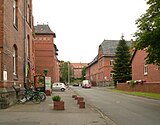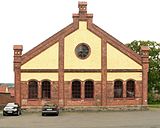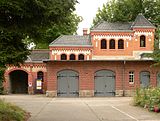Kurhessen barracks
|
|
|||
|---|---|---|---|
| country | Germany | ||
| Coordinates : | 51 ° 24 ' N , 9 ° 38' E | ||
| Opened | 1900 | ||
| Closed | 1993 | ||
| Formerly stationed units | |||
| Engineer Battalion 2 Tank Engineer Company 50 Tank Engineer Company 60 |
|
||
|
Location of the Kurhessen barracks in Lower Saxony |
|||
The Kurhessenkaserne in Hann. Münden in southern Lower Saxony was built in a first phase between 1900 and 1907. It established the location's pioneering tradition . The barracks have had an eventful history through military and non-military use. Today the Fuldablick residential and commercial park is located on the spacious former barracks area . The historic barracks are available as Ensemble listed .
Building history
The barracks on the outskirts of Neumünden on today's B 3 was built by the government master builder Georg Kegel from Kassel. The buildings that were created included a garrison hospital, hall buildings, crew quarters , an officers' mess and a land training area for pioneers. The stately team buildings have a facade design that is borrowed from brick Gothic. The officers' mess is a neo-renaissance style building with curved bent gables. Its cruciform windows and the sandstone portal are reminiscent of the Welfenschloss Münden and the town hall Münden . The garrison hospital with two buildings was located outside the barracks area on the edge of the forest. Its main building has a T-floor plan and stands on a basement made of red sandstone. The building has decorative tail and step gables .
history
At the end of the 19th century there were efforts in Hannoversch Münden, as the place was called at that time, in the magistrate and on the part of leading people to let the city become a garrison again. Before that, military units of the Kingdom of Hanover were stationed in the village until 1866 , partly in the Welfenschloss Münden , which was then used as barracks . Supporters of a renewed deployment of troops included the sculptor Gustav Eberlein , who grew up in Hannoversch Münden , the mayor and several entrepreneurs. Economic benefits were expected for the place. In addition, there was the national sentiment that was enthusiastic about the military at the time. These efforts corresponded to the rearmament efforts of the German Empire at the turn of the century. In 1899 the Prussian War Ministry announced the relocation of a pioneer battalion to the city. In 1900 the foundation stone for the barracks near the Fulda was laid on the site of the monastery chamber. The buildings were built at the expense of the city of Münden for 3 million gold marks and rented to the military.
After the completion of the first barracks in 1901, the Hessian Pioneer Battalion No. 11, which had been in Mainz-Kastel until then , and which was later renamed the Kurhessisches Pioneer Battalion No. 11 , moved into the facility. The battalion was mainly recruited in Kurhessen (see also Kurhessische Army ). During the First World War , a total of 21,000 pioneers were trained in the Kurhessenkaserne between 1914 and 1918 for the war formations of the pioneer battalion. After the war from 1918 the Pioneer Battalion 11 of the Reichswehr moved into the barracks.
During the Weimar Republic , the 11th Pioneer Battalion was disbanded in 1920 and the barracks were no longer used for military purposes. This was based on the reduction of the Reichswehr to a 100,000-man army in accordance with the provisions of the Versailles Treaty . In 1921 the Hessian-Nassau Police School moved into the barracks. Military units did not return until the National Socialism with the Pioneer Battalion 9, which was stationed in the facility now renamed Kurhessenkaserne. During the Second World War , pioneers for frontline operations were trained in the barracks.
In the post-war period , the Kurhessenkaserne served as accommodation for displaced persons . Between 1952 and 1956 it was used by a border guard department and small businesses began to settle there . In 1955, 900 war returnees from the Soviet Union were admitted to the barracks because the Friedland camp was overcrowded .
After the Bundeswehr was set up in 1955, pioneers again moved into the Kurhessenkaserne. From 1956 to 1958, this was the Panzer Pioneer Battalion 5, which was then renamed Pioneer Battalion 2 (PiBtl 2). In addition to PiBtl 2, the garrison also always included independent companies with different names, for example from 1959 to 1981 the Panzerpioniercompanie 50.
After the German reunification in 1990 and the associated troop reductions, the Pioneer Battalion 2 was ceremoniously bid farewell in 1992 with a big tattoo on the Tanzwerder . The Bundeswehr remained in the barracks until the unit was finally dissolved on March 31, 1993. The barracks area, which has been freely accessible since then, is now called the Fuldablick residential and commercial park and is used accordingly.
literature
- Karl Brethauer : Neumünden in: Münden. Collected Essays. First episode. Publisher Hans Fiedler, Hann. Münden, 1984, p. 94
- Monument topography Federal Republic of Germany . Architectural monuments in Lower Saxony, Göttingen district, part 1, volume 5.2, 1993, edited by Urs Boeck , Peter F. Lufen and Walter Wulf, CW Niemeyer book publishers , Hameln, p. 127, ISBN 3-87585-251-6 .
Web links
- Detailed description of history with building plan earlier - today ( Memento from March 10, 2005 in the Internet Archive )
- Private website for the pioneer garrison Hann. Münden
- Aerial photo of the Kurhessenkaserne in the 1970s ( Memento from March 17, 2004 in the Internet Archive )
- Photos of the barracks from 2001 ( Memento from March 15, 2005 in the Internet Archive )
- Photo impressions of today's residential and commercial park
- Colored postcard of the barracks






